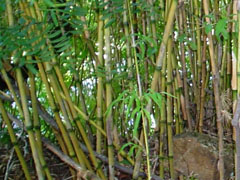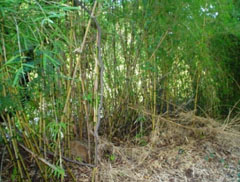 |
|
http://commons.wikimedia.org/wiki/User:Lin_linao |
 |
| http://commons.wikimedia.org/wiki/User:Lin_linao |
Translate this page:
Summary
Physical Characteristics

 Chusquea culeou is an evergreen Bamboo growing to 5 m (16ft) by 2.5 m (8ft) at a fast rate.
Chusquea culeou is an evergreen Bamboo growing to 5 m (16ft) by 2.5 m (8ft) at a fast rate.
See above for USDA hardiness. It is hardy to UK zone 7. It is in leaf all year. The species is hermaphrodite (has both male and female organs) and is pollinated by Wind.
Suitable for: light (sandy), medium (loamy) and heavy (clay) soils. Suitable pH: mildly acid, neutral and basic (mildly alkaline) soils. It can grow in semi-shade (light woodland). It prefers moist soil and can tolerate drought.
UK Hardiness Map
US Hardiness Map
Synonyms
C. andina. C. breviglumis.
Plant Habitats
Woodland Garden Dappled Shade; Shady Edge;
Edible Uses
Edible Parts: Shoots Stem
Edible Uses:
Young shoots - cooked[25, 177].
References More on Edible Uses
Medicinal Uses
Plants For A Future can not take any responsibility for any adverse effects from the use of plants. Always seek advice from a professional before using a plant medicinally.
None known
References More on Medicinal Uses
The Bookshop: Edible Plant Books
Our Latest books on Perennial Plants For Food Forests and Permaculture Gardens in paperback or digital formats.

Edible Tropical Plants
Food Forest Plants for Hotter Conditions: 250+ Plants For Tropical Food Forests & Permaculture Gardens.
More

Edible Temperate Plants
Plants for Your Food Forest: 500 Plants for Temperate Food Forests & Permaculture Gardens.
More

More Books
PFAF have eight books available in paperback and digital formats. Browse the shop for more information.
Shop Now
Other Uses
Musical Wood
The canes are used in making musical instruments, plain furniture and fencing[139].
Special Uses
References More on Other Uses
Cultivation details
Prefers a damp humus rich soil[200]. Prefers an open loam of reasonable quality, doing well on peat[11]. Likes plenty of moisture in the growing season[11]. Established plants are drought tolerant[25, 162, 195]. They require a position sheltered from cold north and east winds[11, 200]. A very hardy plant[25, 162], tolerating temperatures down to about -15°c[200]. Another report says that the plant is probably only hardy in the milder areas of the country[1]. It succeeds outdoors at Edinburgh Botanical Gardens[195] and is growing well at Kew[K]. This species is found further south in the world than any other species of bamboo, it grows in Chile as far south as latitude 47°south[195]. The rootstock is caespitose, new shoots are produced from late April and can grow 15cm overnight[25]. Plants take 2 - 3 years to settle down after being moved but are then quite fast growing[162]. Another report says that they are slow growing[188]. This species is notably resistant to honey fungus[200]. Plants flower and produce seed annually in the wild without dying as a result of the flowering[162]. Plants of the cultivar 'Tenuis' have been observed to be flowering in 1994, this is the first record of this species flowering in the northern hemisphere[214].
References Carbon Farming Information and Carbon Sequestration Information
Temperature Converter
Type a value in the Celsius field to convert the value to Fahrenheit:
Fahrenheit:
The PFAF Bookshop
Plants For A Future have a number of books available in paperback and digital form. Book titles include Edible Plants, Edible Perennials, Edible Trees,Edible Shrubs, Woodland Gardening, and Temperate Food Forest Plants. Our new book is Food Forest Plants For Hotter Conditions (Tropical and Sub-Tropical).
Shop Now
Plant Propagation
Seed - surface sow as soon as it is ripe in a greenhouse at about 20°c. Do not allow the compost to dry out. Germination usually takes place fairly quickly so long as the seed is of good quality, though it can take 3 - 6 months. Grow on in a lightly shaded place in the greenhouse until large enough to plant out. Seed is rarely available. Division in spring as new growth commences. Very difficult[200]. Take divisions with at least four canes in the clump, trying to cause as little root disturbance to the main plant as possible. Grow them on in light shade in a greenhouse in pots of a high fertility sandy medium. Mist the foliage regularly until plants are established. Plant them out into their permanent positions when a good root system has developed, which can take a year or more[200]. Basal cane cuttings.
Other Names
If available other names are mentioned here
Native Range
SOUTHERN AMERICA: Argentina (Chubut, Neuquén, Río Negro), Chile (La Araucanía, Los Lagos)
Weed Potential
Right plant wrong place. We are currently updating this section.
Please note that a plant may be invasive in one area but may not in your area so it's worth checking.
Conservation Status
IUCN Red List of Threatened Plants Status :

Growth: S = slow M = medium F = fast. Soil: L = light (sandy) M = medium H = heavy (clay). pH: A = acid N = neutral B = basic (alkaline). Shade: F = full shade S = semi-shade N = no shade. Moisture: D = dry M = Moist We = wet Wa = water.
Now available:
Food Forest Plants for Mediterranean Conditions
350+ Perennial Plants For Mediterranean and Drier Food Forests and Permaculture Gardens.
[Paperback and eBook]
This is the third in Plants For A Future's series of plant guides for food forests tailored to
specific climate zones. Following volumes on temperate and tropical ecosystems, this book focuses
on species suited to Mediterranean conditions—regions with hot, dry summers and cool, wet winters,
often facing the added challenge of climate change.
Read More
Expert comment
Author
E.Desv.
Botanical References
11200
Links / References
For a list of references used on this page please go here
Readers comment
© 2010, Plants For A Future. Plants For A Future is a charitable company limited by guarantee, registered in England and Wales. Charity No. 1057719, Company No. 3204567.